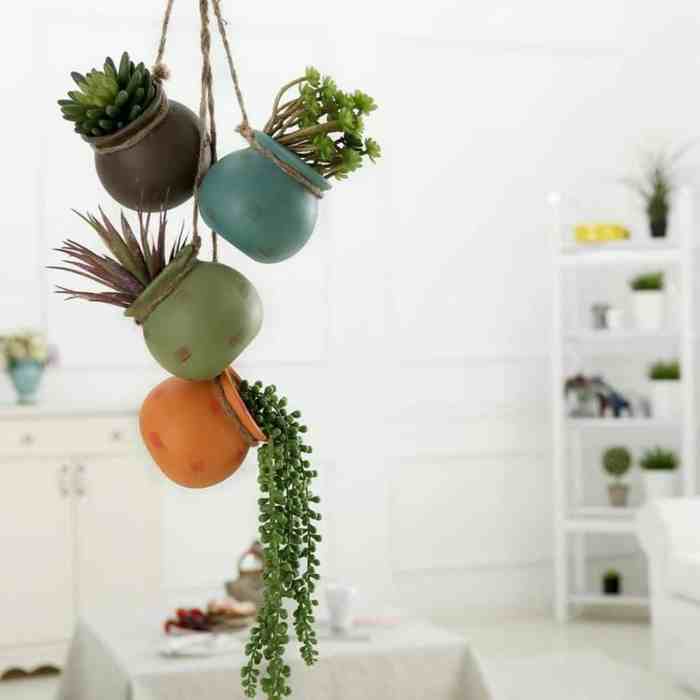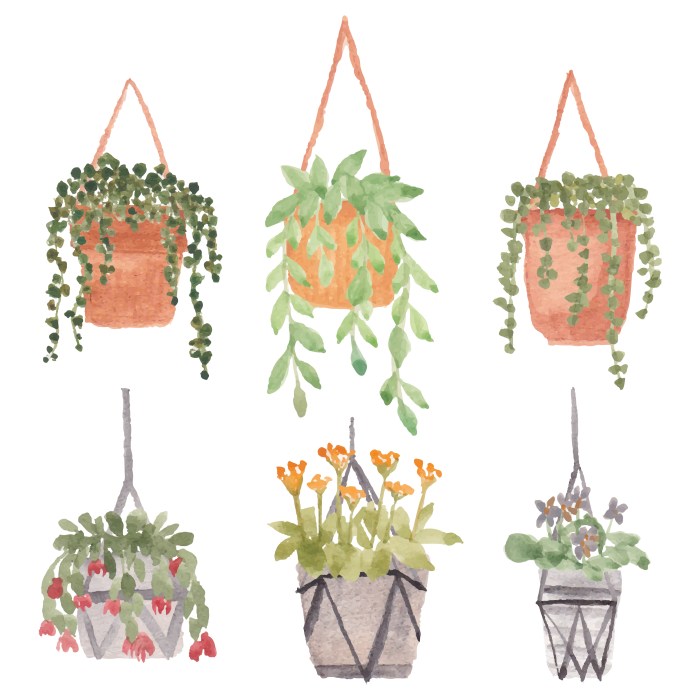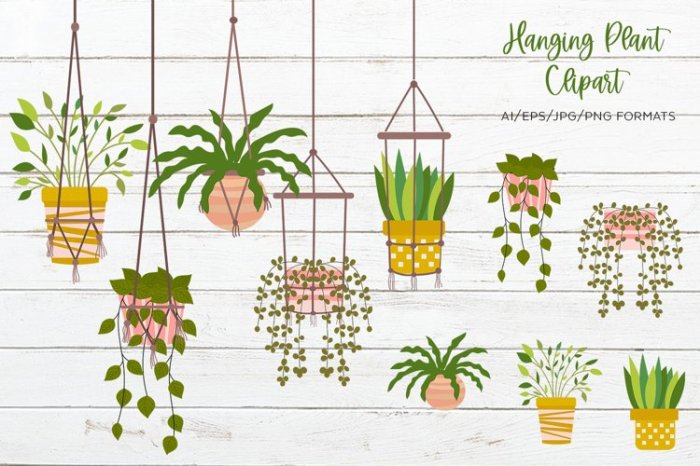10 hanging plants graphic presents an enchanting guide to the world of hanging plants, showcasing their aesthetic appeal and practical benefits. With captivating visuals and expert insights, this guide inspires readers to transform their homes and gardens into vibrant oases.
Discover a wide range of hanging plant species, from cascading ferns to trailing succulents, each with unique characteristics and care requirements. Learn how to choose the perfect hanging plants for your space, whether you seek to brighten a dim corner or create a lush vertical garden.
Visual Appeal of Hanging Plants

Hanging plants have become increasingly popular due to their ability to add a touch of greenery and life to any space. They can be used to create a variety of looks, from lush and tropical to modern and minimalist.
One of the biggest benefits of hanging plants is that they can be placed in areas where there is limited floor space. This makes them a great option for small apartments, offices, or other tight spaces. They can also be used to add height and interest to a room, and to create a more layered look.
Choosing the Right Hanging Plants
When choosing hanging plants, it is important to consider the size of the space, the amount of light available, and the overall style of the room. For small spaces, smaller plants are a good option. For larger spaces, larger plants can be used to create a more dramatic effect.
Plants that require a lot of light should be placed in areas that receive bright, indirect light. Plants that can tolerate low light can be placed in areas that receive less light.
Types of Hanging Plants

Hanging plants add a touch of greenery and life to any indoor or outdoor space. They come in various species, each with unique characteristics and care requirements. Understanding the different types of hanging plants can help you make informed choices for your specific needs.
Hanging plants can be broadly classified into three main categories based on their growth habits: trailing, cascading, and vining.
Trailing Hanging Plants
- Spider Plant (Chlorophytum comosum) : Produces long, trailing stems with variegated leaves. Easy to care for and can tolerate low light.
- String of Pearls (Senecio rowleyanus) : Features delicate, bead-like leaves that trail downwards. Prefers bright, indirect light.
- Burro’s Tail (Sedum morganianum) : Known for its plump, fleshy leaves that resemble a donkey’s tail. Thrives in bright, indirect light.
Plant Care and Maintenance: 10 Hanging Plants Graphic

Maintaining the health and beauty of hanging plants requires proper care and attention. Understanding their specific needs is essential to ensure their thriving and longevity.
Watering
Watering is a crucial aspect of hanging plant care. The frequency depends on the plant species, pot size, and environmental conditions. In general, allow the soil to dry out slightly between waterings, avoiding overwatering. Use lukewarm water and water thoroughly, allowing excess water to drain out.
Fertilizing
Fertilizing provides essential nutrients for hanging plants. Use a balanced liquid fertilizer diluted to half strength during the growing season (spring and summer). Follow the instructions on the fertilizer label carefully, avoiding over-fertilizing.
Pruning
Regular pruning promotes healthy growth and removes dead or damaged foliage. Trim overgrown stems, remove yellowed leaves, and cut back leggy growth to encourage fullness.
Whether you’re a seasoned plant enthusiast or just starting your indoor garden journey, 10 hanging plants graphic provides a comprehensive guide to the world of hanging plants. For those seeking further inspiration and expertise, Hanging Plants Garden: A Guide to Vertical Gardening and Design offers an in-depth exploration of vertical gardening techniques and design principles, ensuring your hanging plants thrive and create a captivating indoor oasis.
Light Exposure
Most hanging plants prefer bright, indirect light. Avoid direct sunlight, as it can scorch the leaves. Choose a location that provides ample natural light but is not in the direct path of the sun.
Humidity
Hanging plants thrive in humid environments. Misting the leaves regularly or using a humidifier can increase humidity levels. Alternatively, group plants together to create a microclimate that retains moisture.
Temperature
Hanging plants prefer warm temperatures. Most species do well in temperatures between 65-80°F (18-27°C). Avoid placing plants near drafts or cold windows.
Troubleshooting Common Problems
Hanging plants may encounter various problems, such as yellowing leaves, pests, and root rot. Identifying the cause and taking appropriate action is crucial for resolving these issues.
While our 10 hanging plants graphic provides visual inspiration, for cat owners, Hanging Plants for Cats: Enhancing Feline Well-being offers expert insights on the benefits of hanging plants for feline health and happiness. Return to our 10 hanging plants graphic for more design ideas.
- Yellowing leaves:Can indicate overwatering, underwatering, or nutrient deficiency. Adjust watering frequency or fertilize accordingly.
- Pests:Aphids, mealybugs, and spider mites are common pests that can infest hanging plants. Use insecticidal soap or neem oil to control infestations.
- Root rot:Overwatering or poor drainage can lead to root rot. Remove the affected plant from the pot, trim any damaged roots, and repot in fresh soil with good drainage.
Creative Display Ideas
Hanging plants offer a unique and versatile way to add greenery and style to any space. With a little creativity, you can create stunning displays that will transform your home into a lush oasis.
One popular way to display hanging plants is to use macrame hangers. These hangers are made from knotted cords and can be used to create a variety of different looks, from simple and understated to elaborate and bohemian.
Macrame Hangers
- Macrame hangers are a versatile and stylish way to display hanging plants.
- They can be used to create a variety of different looks, from simple and understated to elaborate and bohemian.
- Macrame hangers are relatively easy to make, and there are many different tutorials available online.
Hanging Baskets
Another popular option for displaying hanging plants is to use hanging baskets. These baskets are typically made from metal, wicker, or plastic and can be hung from the ceiling or from a wall-mounted bracket.
- Hanging baskets are a great way to add height and dimension to a room.
- They can be used to create a variety of different looks, from traditional to modern.
- Hanging baskets are relatively easy to install, and there are many different styles and sizes available.
Other Accessories
In addition to macrame hangers and hanging baskets, there are a number of other accessories that can be used to create unique and stylish displays for hanging plants.
- Wall-mounted planters: These planters are mounted directly to the wall and can be used to create a vertical garden.
- Ceiling hooks: These hooks can be used to hang plants from the ceiling, creating a dramatic and eye-catching display.
- Plant stands: These stands can be used to elevate plants off the ground, creating a more formal look.
Vertical Gardening
Hanging plants can also be used to create vertical gardens. Vertical gardens are a great way to add greenery to small spaces or to create a living wall.
The 10 hanging plants graphic showcases a variety of lush greenery that can transform any indoor space. For those seeking to bring these beautiful plants into their homes, plants bunnings offers a wide selection of hanging plants to choose from.
With their cascading foliage and air-purifying qualities, these plants not only add a touch of nature but also contribute to a healthier indoor environment. The 10 hanging plants graphic provides inspiration and guidance for selecting the perfect plants to create a vibrant and inviting living space.
- Vertical gardens can be created using a variety of different methods, including macrame hangers, hanging baskets, and wall-mounted planters.
- Vertical gardens are a great way to add greenery to small spaces or to create a living wall.
- Vertical gardens can help to improve air quality and reduce stress.
Plant Selection for Specific Needs

When selecting hanging plants, it is essential to consider their specific needs to ensure their health and well-being. Different plants thrive under varying conditions, and choosing the right ones for your environment is crucial.
10 hanging plants graphic provides a visual representation of the diverse options available for vertical gardening. From trailing vines to cascading foliage, these plants can transform any wall into a vibrant oasis. For a comprehensive guide to creating a lush vertical garden, refer to Hanging Plants from Wall: A Guide to Vertical Gardening . This resource offers expert tips on plant selection, installation, and maintenance, ensuring your hanging plants thrive and add beauty to your indoor space.
Explore the 10 hanging plants graphic for inspiration and embark on the journey of vertical gardening.
Factors to consider include light availability, humidity levels, and pet safety. Some plants excel in low-light conditions, while others prefer bright, indirect light. Similarly, some plants require high humidity, while others can tolerate drier environments.
Ideal Hanging Plants for Different Needs, 10 hanging plants graphic
| Need | Ideal Hanging Plants | Key Features | Care Requirements |
|---|---|---|---|
| Low Light | Pothos, Snake Plant, ZZ Plant | Tolerant of low light levels, easy to care for | Water when soil is dry to the touch, fertilize monthly |
| High Humidity | Ferns, Air Plants, Orchids | Require high humidity levels, can be misted regularly | Water when soil is slightly moist, fertilize every 2-3 months |
| Pet-Friendly | Spider Plant, Peperomia, African Violet | Non-toxic to pets, safe to have around | Water when soil is dry to the touch, fertilize monthly |
Additionally, consider the plant’s size, growth rate, and toxicity when selecting hanging plants. Larger plants may require more space and support, while faster-growing plants will need more frequent pruning. Toxic plants should be avoided in homes with pets or children.
Conclusive Thoughts
Whether you’re a seasoned plant enthusiast or a novice gardener, 10 hanging plants graphic empowers you to create stunning hanging displays that will add a touch of nature and tranquility to your living spaces.
FAQ Guide
What are the benefits of hanging plants?
Hanging plants purify the air, reduce stress, and add a touch of greenery to any space.
How do I choose the right hanging plants for my home?
Consider the light conditions, humidity, and space available when selecting hanging plants.
What are some creative ways to display hanging plants?
Use macrame hangers, hanging baskets, or shelves to create unique and stylish displays.